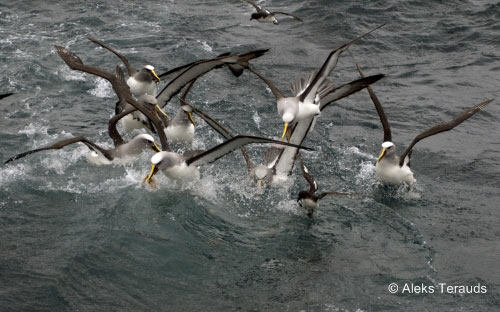Johanna Pierre (Dragonfly Science, Wellington, New Zealand) and colleagues have produced a report for the New Zealand Department of Conservation that looks at seabird bycatch mitigation in New Zealand’s Scampi Metanephrops challengeri fishery.
Seabird species reported caught by the fishery include Buller’s Albatross Thalassarche bulleri, Salvin’s Albatross T. salvini, Campbell Albatross T. impavida, White-capped Albatross T. steadi, Black Petrel Procellaria parkinsoni, giant petrels Macronectes spp., White-chinned Petrel Procellaria aequinoctialis, Flesh-footed Shearwater Puffinus carneipes, Sooty Shearwater P. griseus and Pintado or Cape Petrel Daption capense.
The report’s Executive Summary follows:
“Seabird bycatch rates in the scampi fishery are estimated to be the second highest amongst New Zealand trawl fisheries. Seabird captures in this fishery are exacerbated by characteristics of the fishing operation: the gear is at or near the sea-surface for extended periods during shooting and hauling, and the catch typically comprises over 80% fish and invertebrate bycatch, which is discharged at the fishing grounds. A substantial body of work exists on seabird bycatch reduction measures for trawl fisheries. However, characteristics of scampi trawl gear and the prevalence of net captures amongst bycaught birds (for which no deployment-ready mitigation measures are available) present challenges for reducing seabird catch in this fishery. This project sought to identify potential methods with which to mitigate seabird captures in the New Zealand scampi fishery, test the feasibility and effectiveness of these methods, and make recommendations on future work on seabird bycatch in this fishery. Through reviewing available information and holding an expert workshop (including representatives from the scampi fishing industry), we identified three areas for work: improving batch discharge regimes to ensure discharge is held on board during shooting and hauling; improving the design and construction of paired streamer lines; and testing the ‘net restrictor’ – a novel approach to reducing seabird captures in scampi nets. The first two areas of work will be addressed on an ongoing basis through working with skippers and crews, and utilising observer coverage of scampi vessels. Deployment of the net restrictor prevents the mouth of the net from becoming wide open during shooting and hauling. First, we examined the operational feasibility of the restrictor in the centre net of a triple-rig targetting scampi. Then, we designed an experiment to test the efficacy of the restrictor in reducing seabird catch. Constraints on government observer coverage prevented the implementation of this experiment during the course of the project. However, implementing data collection protocols in future years on observed trips where vessels are using net restrictors will allow the assessment of the efficacy of the net restrictor in reducing seabird catch. Footage collected using underwater cameras confirmed that the height of the centre net in triple-rig scampi gear was reduced by approximately 75% when restrictor ropes were in place. Footage also showed that the headline and some of the body of mesh around the headline sat lower in the water column with restrictors in place than without. While not a substitute for a designed experiment, this footage is a preliminary indication that the restrictor may be effective in reducing the risk of seabird bycatch in centre nets at shooting and hauling. We recommend empirical testing of the efficacy of net restrictors in this, and potentially other, demersal fisheries in which seabirds are caught in trawl nets.”

Buller's Albatrosses and Pintado Petrels follow a fishing vessel. Photograph by Aleks Terauds
Reference:
Pierre, J.P., Cleal, J., Thompson, F.N. & Abraham, E.R. 2013. Seabird Bycatch Reduction in Scampi Trawl Fisheries. Final Research Report for Department of Conservation Project MIT2011-02. Wellington: Department of Conservation. 26 pp.
John Cooper, ACAP Information Officer, 18 June 2013

 English
English  Français
Français  Español
Español